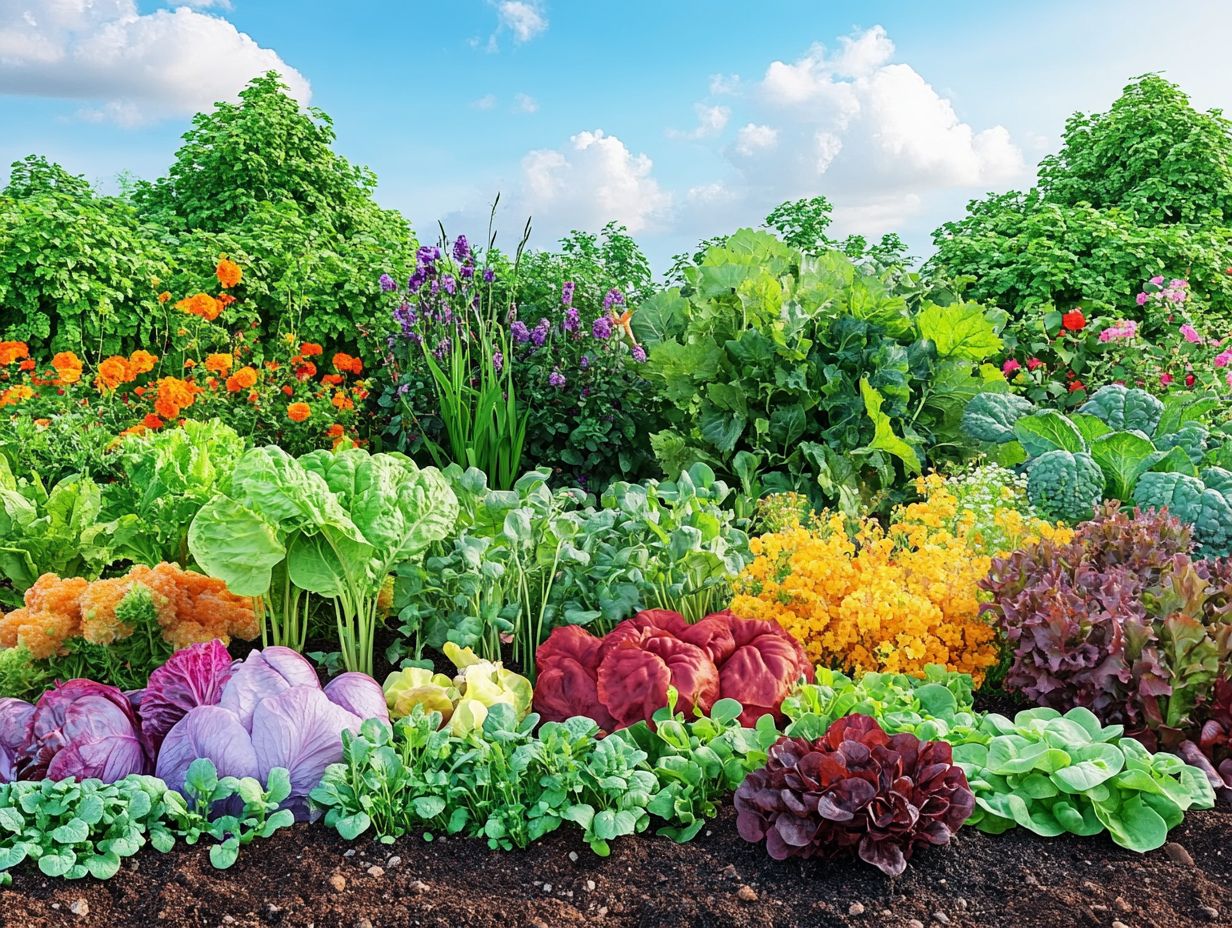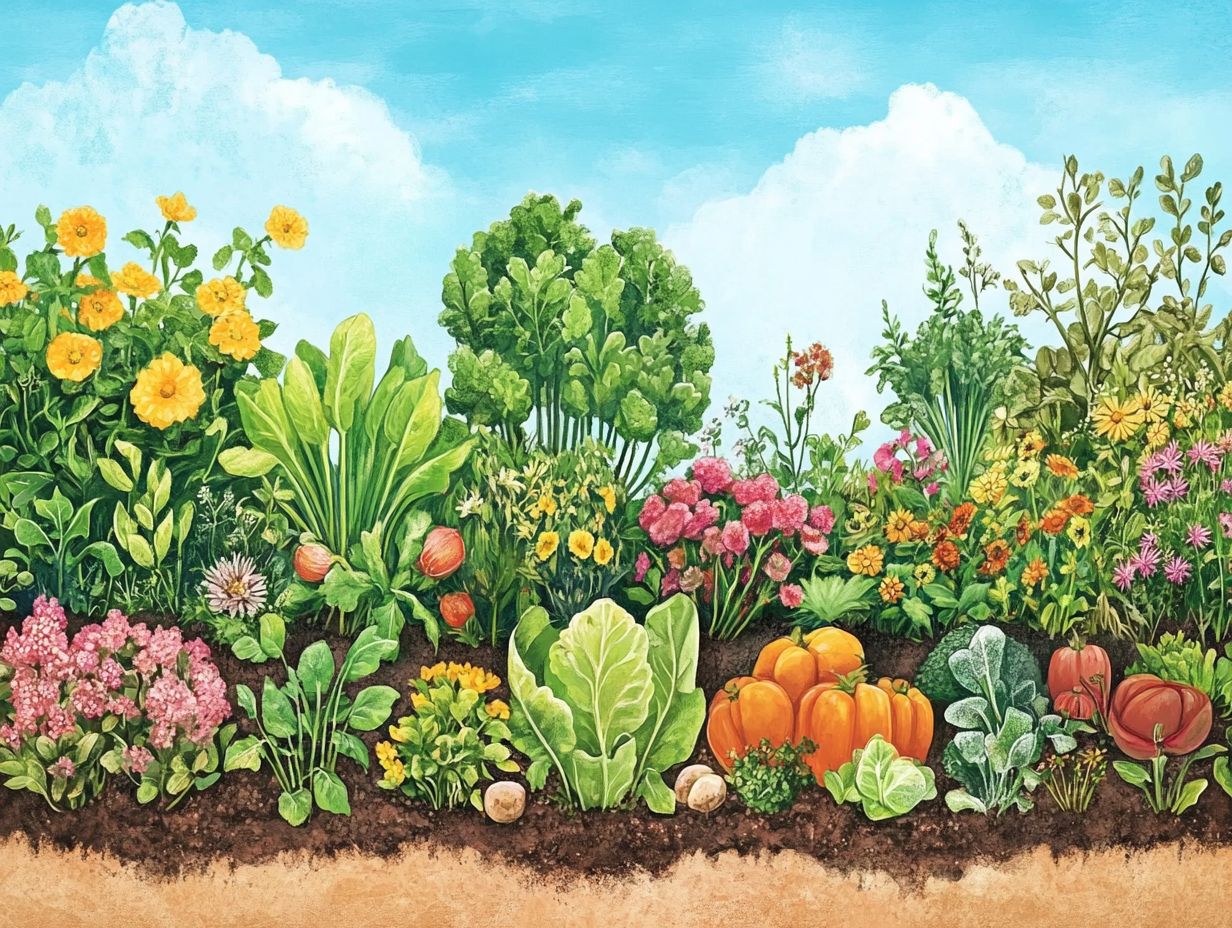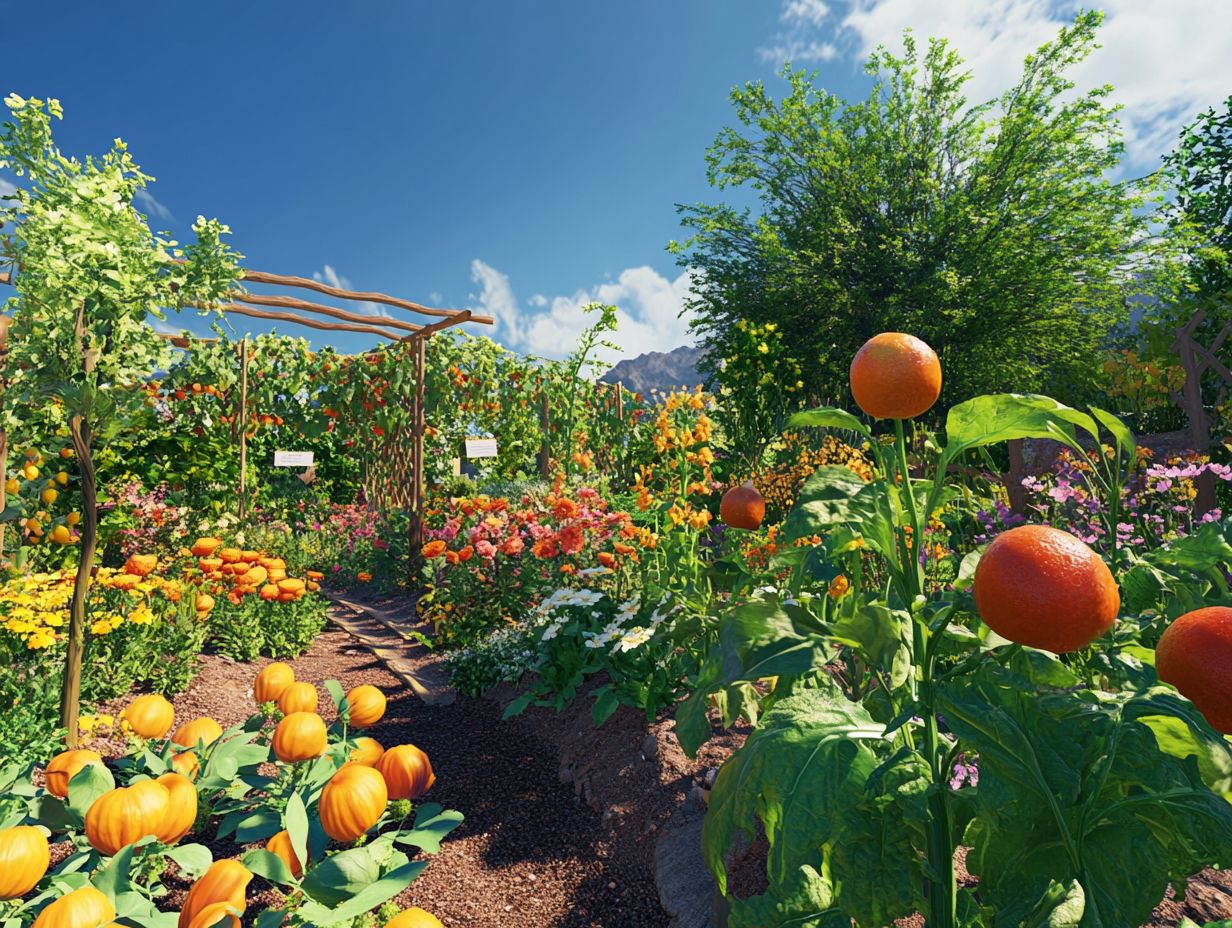Understanding Edible Plant Seasons
Understanding the seasons of edible plants is essential for savoring fresh, nutritious produce throughout the year, especially when it comes to gardening.
From the vibrant greens of spring to the hearty roots of winter, each season presents a distinctive array of flavors and health benefits. This provides ample opportunities for vegetable gardening. By knowing the best timing to plant and harvest, you can elevate your culinary experiences while championing environmental sustainability through gardening practices.
This exploration delves into the significance of recognizing edible plant seasons, the various factors that influence them, and gardening tips for identifying your seasonal favorites. Embark on a journey through nature s abundant offerings in your vegetable patch!
Contents
- Key Takeaways:
- What are Edible Plant Seasons?
- Why is it Important to Know Edible Plant Seasons?
- Factors that Affect Edible Plant Seasons
- Soil Conditions
- Planting and Harvesting Techniques
- Benefits of Eating Seasonally
- How to Identify Edible Plants in Each Season
- Frequently Asked Questions
- What are edible plant seasons, guided by local horticulturists and gardening experts?
- Why is it important to understand edible plant seasons?
- How can I determine the edible plant seasons in my area?
- What are some common edible plants and their seasons?
- Are there any risks associated with consuming plants out of season?
- Can I still enjoy edible plants outside of their peak season?
Key Takeaways:

- Eating seasonally ensures fresher and more flavorful produce, along with better nutrition from diverse vegetable varieties.
- Understanding edible plant seasons can help reduce our carbon footprint and support local farmers practicing sustainable gardening.
- Factors such as climate, soil temperature, and planting methods greatly influence when certain crops are in season.
What are Edible Plant Seasons?
Understanding the seasons for edible plants is crucial for your success in edible gardening and horticulture. It empowers you to optimize your efforts by selecting the best timing for planting and harvesting various crops.
Timing is essential for enjoying fresh produce year-round while employing effective planting methods based on your local climate conditions. When you know the right time to plant, you ll be on your way to a thriving garden!
Why is it Important to Know Edible Plant Seasons?
Knowing edible plant seasons is vital for anyone invested in sustainable gardening practices. This knowledge directly impacts soil health and crop rotation strategies. The result is better yields and greater gardening success in both edible landscaping and vegetable gardening.
By grasping these seasonal dynamics, you can devise a robust plan that enhances soil fertility through the strategic use of cover crops and organic fertilizers. You’ll be able to effectively manage planting schedules and optimize your garden design, ensuring that your garden beds thrive year-round without depleting vital nutrients.
Timely crop rotation is a key factor as it minimizes pests and diseases while fostering a balanced ecosystem in your garden. With this knowledge, both novice and seasoned gardeners can make informed choices about plant selection that significantly contribute to a thriving garden and enhance personal satisfaction and environmental sustainability.
Factors that Affect Edible Plant Seasons
Several factors influence the seasons for edible plants in your garden, including climate and weather patterns, soil conditions, and a range of planting techniques. Each of these elements can present unique challenges that impact your crop success.
Understanding these variables is essential for cultivating a flourishing garden and mastering your gardening skills.
Climate and Weather Patterns
Climate and weather are pivotal in determining the ideal timing for planting and harvesting edible plants. They govern the temperature and conditions essential for the optimal growth of various crops.
For example, if you live in an area where winter is biting and summer feels like a furnace, you should pay close attention to your local climate and soil temperature. Temperature swings can significantly affect germination and growth rates, making it crucial to understand your local hardiness zones, which indicate the types of plants that can thrive based on local weather conditions.
By mastering this knowledge, you can elevate your gardening skills and cultivate resilient crops that flourish in harmony with their environment, leading to bountiful harvests in your vegetable patch.
Ready to transform your garden? Start planning your seasonal planting today!
Soil Conditions

Soil conditions are fundamental to your success in edible gardening. They play a crucial role in your gardening experience, making soil testing essential for any gardener aspiring to gain expertise.
By understanding these conditions, you can select the right crops and ensure that each plant receives the nutrients it needs to thrive. This can be achieved through appropriate organic fertilizers. Healthy soil acts as a vibrant ecosystem, supporting beneficial microorganisms and organic matter. This greatly enhances productivity in your gardening efforts.
Using organic fertilizers will improve your soil structure and enrich its nutrient content. This promotes a sustainable approach to gardening and edible landscape design. Regular soil testing allows you to pinpoint deficiencies and fine-tune your gardening practices accordingly.
Equipping yourself with the appropriate gardening tools can streamline maintaining optimal soil conditions. This makes it easier for you to cultivate a diverse array of vegetables.
Planting and Harvesting Techniques
Effective planting and harvesting techniques are essential for maximizing the yield of your edible plants. You’ll want to employ various planting methods and timing strategies that promote optimal vegetable growth.
One method to consider is succession planting. This strategy involves planting different vegetable varieties at intervals instead of all at once. This creates a staggered harvest, allowing you to enjoy fresh produce and herbs over an extended period. For instance, planting a new batch of lettuce every two weeks ensures a continuous supply throughout the season, contributing to your sustainable gardening goals.
Incorporating crop rotation, which means changing where you plant different vegetables each year, enhances soil fertility. It also helps deter pests and supports effective gardening practices, boosting your overall yield.
Explore using raised beds, which improve drainage and accessibility. Raised beds make your gardening experience more efficient and rewarding while allowing for better space management.
Benefits of Eating Seasonally
By embracing seasonal eating and incorporating local produce into your diet, you unlock numerous benefits. Fresh produce boasts enhanced nutritional value, supports sustainable gardening practices, and promotes healthy gut maintenance.
This approach nurtures the environment and elevates your overall gardening experience. It helps you connect with nature, making each bite more meaningful and supportive of your gardening efforts.
Nutritional Benefits
Seasonal vegetables and fresh herbs are rich in nutritional value. They offer a wealth of vitamins and minerals that often surpass those found in out-of-season produce, making them essential in your gardening practices.
These vibrant foods bolster a strong immune system, aid in maintaining a healthy gut, and promote overall well-being. Leafy greens like kale, spinach, and asparagus are brimming with antioxidants and essential nutrients such as iron and calcium.
Herbs like basil and cilantro deliver impressive anti-inflammatory benefits and can be easily grown in your container gardening projects.
By cultivating these seasonal varieties, you experience the gratifying journey of nurturing your own food sources. This enhances mental wellness and deepens your connection to nature. This relationship between gardening and nutrition encourages a lifestyle centered around healthful eating and sustainable practices, benefiting both you as the grower and your community as consumers of local produce.
Environmental Benefits
The environmental benefits of eating seasonally are impressive! It allows you to support sustainable gardening practices, promote local produce, and enhance crop diversity. All of these contribute to a healthier ecosystem and effective ecological plant selection.
By choosing to enjoy foods that are in season, you can significantly reduce the carbon footprint associated with food transportation. This contributes to a more sustainable lifestyle. Seasonal eating reduces the need for long-distance shipping, a major contributor to greenhouse gas emissions, which can be alleviated through supporting local farmers.
Focusing on locally sourced seasonal items encourages farmers to adopt varied planting schedules, essential for maintaining soil health and preventing pest outbreaks in a sustainable gardening environment. This variety not only boosts local biodiversity but also enhances resilience against climate fluctuations, creating a balanced ecosystem where both flora and fauna can thrive together in harmony through effective ecological practices.
How to Identify Edible Plants in Each Season

Identifying edible plants in each season demands good knowledge of seasonal vegetables and refined gardening skills, including container gardening techniques. This knowledge gives you the power to make informed plant selections that align perfectly with seasonal availability.
These selections ensure a bountiful harvest throughout the year and contribute to your gardening success.
Common Edible Plants in Spring
Spring is the perfect time to dive into the world of edible gardening! It showcases a delightful selection of plants like asparagus, kale, and garlic, alongside cool-season vegetables that thrive in the cooler temperatures.
This season allows you to cultivate these flavorful varieties, enhancing your meals and contributing to a flourishing garden ecosystem. Take asparagus, for example; it flourishes in well-drained soil, ideal for vegetable gardening, and requires a sunny spot, perfect for growing fresh herbs, making it an ideal candidate for early planting.
Kale, on the other hand, relishes the cooler weather and can be sown directly into the soil. It thrives on rich nutrients and requires consistent watering. Garlic prefers a slightly acidic pH (a measure of soil acidity) and is best planted in the fall to yield a bountiful spring harvest.
To ensure your success with these spring staples, keep a close eye on soil moisture, which is critical for maintaining soil health, and maintain proper spacing between plants. Paying attention to details helps plants grow and improves airflow, leading to a thriving garden that you can be proud of.
Common Edible Plants in Summer
Summer unveils a delightful array of edible plants, such as tomatoes and blueberries, that thrive in the warmth! These provide you with fresh produce that elevates your meals and satisfies your culinary cravings.
These vibrant fruits and vegetables not only adorn your plates but also deliver essential nutrients crucial for your well-being. To cultivate tomatoes successfully, ensure they bask in abundant sunlight and take root in well-drained soil.
On the other hand, blueberries thrive in acidic environments with ample moisture, making the right conditions paramount for their growth. Selecting disease-resistant varieties can significantly enhance your harvest a key factor in sustainable gardening.
Regular watering, thoughtful mulch, which contributes to soil health, and vigilant pest monitoring are essential practices to maintain their health and vitality. By choosing the right plants and nurturing them with care, you can transform your garden into a flourishing source of joy and nourishment! Start your own seasonal garden today and enjoy the benefits of fresh, local produce!
Common Edible Plants in Fall
Fall is a pivotal time for you to harvest a wide variety of edible plants. Native ones like Jerusalem artichokes signal the end of the growing season.
This season, you ll love discovering other seasonal treasures such as kale, carrots, and winter squash that flourish as temperatures begin to drop. Understanding the timing of these crops is essential, as many actually need a light frost, which is beneficial for crops like kale to reach their peak flavor.
When you harvest, using a gentle touch is vital for handling your vegetable patch, along with the right tools to minimize damage and ensure a successful collection.
It’s also prudent to prepare your garden for winter by adding mulch and incorporating compost, a great organic fertilizer for enriching the soil. This can significantly enhance the soil quality for the upcoming spring. This attention to detail nurtures your current harvest and prepares your garden for future seasons.
Common Edible Plants in Winter
While winter may pose its fair share of gardening challenges, it also opens the door to cultivating hardy crops, including plants that come back year after year, perfect for creating an edible landscape like kale and garlic, which thrive in cooler temperatures.
By selecting the right edible plants suited for colder climates, you can revel in a diverse harvest, achieved through succession planting and careful plant selection even as most flowers fade away. Techniques like using row covers, which are lightweight sheets that protect plants from frost, and cold frames, structures that trap heat to shield your crops in winter, not only shield these resilient varieties from harsh elements but also extend your growing season, giving you an edge against the frost.
Equipping yourself with the right gardening tools like shovels and trowels can make a significant difference think frost-resistant shovels, essential gardening tools for winter preparation, and ergonomic hand trowels, making gardening tasks easier on your hands. Embracing these practices allows you to transform those chilly months into a fruitful gardening experience, enhancing your overall gardening skills, ensuring your efforts flourish even in the frost’s embrace.
Frequently Asked Questions

What are edible plant seasons, guided by local horticulturists and gardening experts?
Edible plant seasons refer to the specific times of the year when certain plants are at their peak for consumption. Understanding these cycles can be enhanced by exploring the life cycle of edible plants, as they can vary based on weather, climate, and geographic location.
Why is it important to understand edible plant seasons?
Understanding edible plant seasons allows you to know which plants are best to eat at certain times of the year. This ensures the freshest and most flavorful produce while promoting sustainability and supporting local agriculture. For more insights, check out understanding seasonal changes in edible plants.
How can I determine the edible plant seasons in my area?
The best way to determine edible plant seasons in your area is to research your local climate and growing conditions. You can also consult with local farmers or visit farmers markets to see what produce is available at different times of the year.
What are some common edible plants and their seasons?
Some common edible plants and their seasons include strawberries in spring, tomatoes in summer, pumpkins in fall, and root vegetables in winter. However, these may vary depending on your location.
Are there any risks associated with consuming plants out of season?
Yes, consuming plants out of season may result in lower nutritional value, decreased flavor, and increased pesticide use. It is best to stick to eating plants during their peak season for optimal taste and health benefits.
Can I still enjoy edible plants outside of their peak season?
Yes! You can still enjoy edible plants even when they are not in season.
Look for frozen or canned options, or buy locally-grown produce from areas where the plants are in season.






